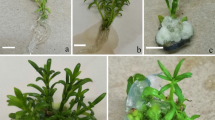Abstract
A micropropagation protocol of parsley,Petroselinum crispum (Mill.) Nyman (curled type) has been developed. Surface-sterilized axillary buds cultured on Murashige and Skoog medium supplemented with benzyladenine, kinetin, or thidiazuron developed axillary shoots (rosettes). Kinetin resulted in only a low proliferation rate. The concentrations of thidiazuron or benzyladenine that were optimal for shoot proliferation, resulted in shoots with a low capability to root. During the rooting treatment, these shoots showed wilting signs. Rooting was increased significantly by using a two-week inductive stage with 2.5 μM naphthaleneacetic acid directly followed by acclimatization. Two proliferation media (5 μM benzyladenine and 0.5 μM naphthaleneacetic acid or 5 μM kinetin and 2.5 μM naphthaleneacetic acid) resulted in moderate proliferation but produced shoots that were easy-to-root. These media have been tested by repeated axillary proliferation on the same medium. The medium with 5 μM benzyladenine and 0.5 μM naphthaleneacetic acid was optimal.
Similar content being viewed by others
Abbreviations
- BA:
-
6-Benzyladenine
- IBA:
-
Indole-3-butyric acid
- MS:
-
Murashige & Skoog
- NAA:
-
α-Naphthaleneacetic acid
References
De Klerk GJ (1990) How to measure somaclonal variation. Acta Bot. Neerl. 39: 129–144
Dostal J & Skladal V (1979) Klonovani KvetakuBrassica oleracea L. var.botrytis L.)in vitro. Sbornik Uvtiz-Zahradnictvi 5–6: 177–185
Masuda K, Koda Y & Okazawa Y (1977) Callus formation and embryogenesis of endosperm tissues of parsley seed cultured on hormone-free medium. Physiol. Plant. 41: 135–138
Murashige T & Skoog F (1962) A revised medium for rapid growth and bioassays with tobacco tissue cultures. Physiol. Plant. 15: 473–497
Porter NG (1989) Composition and yield of commerical essential oils from parsley. 1: herb oil and crop development. Flavour and Fragrance Journal 4: 207–219
Vandemoortele JL, Billard JP, Boucaud J & Gaspar Th (1994) Régénération de plantules à partir de cals issus de pétioles dePetroselinum crispum (Mill.) Nyman. Med. Fac Landbouww. Univ. Gent. 59/3b: 1455–1459
Vasil IK & Hildebrandt AC (1966) Variations of morphogenetic behaviour in plant tissue cultures II.Petroselinum hortense. Amer. J. Bot. 53: 869–874
Watin C & Bigot C (1989) Régénération de plantes fertiles à partir de cals embryogènes de persil commun (Petroselinum hortense Hoffm.). C.R. Acad. Sci. série III 309: 653–659
Zheng GQ, Kenney PM & Lam LKT (1992) Myristicin: a potential cancer chemoprotective agent from parsley leaf oil. J. Agric. Food Chem. 40: 107–110
Author information
Authors and Affiliations
Rights and permissions
About this article
Cite this article
Vandemoortele, J.L., Billard, J.P., Boucaud, J. et al. Micropropagation of parsley through axillary shoot proliferation. Plant Cell Tiss Organ Cult 44, 25–30 (1996). https://doi.org/10.1007/BF00045909
Received:
Accepted:
Issue Date:
DOI: https://doi.org/10.1007/BF00045909




